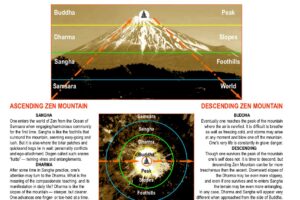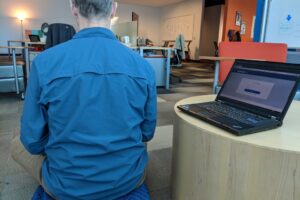
Yes, revolution, not resolution. A difference of two letters of the alphabet, s and v, separated by tu – Latin for “you.” Apropos of the orientation of this article — it is all about you. Herein we want to concern ourselves with revolution in the new year, not the mere resolutions that we may make for the new year (or make up as we go along). We will come back to the idea of revolution, but first a diversionary foray into the vernacular: Why not resolution?
RESOLUTION
Resolution has the root resolve, which boasts multiple and varied connotations in its definitions set, according to the version of the New Oxford American Dictionary residing somewhere deep in the silicone bowels of my desktop Mac:
One meaning of resolve, the verb, is to “settle or find a solution to a problem, dispute or contentious matter.” Another is musical: “of a discord lead[ing] into a concord during the course of harmonic change.” Yet another goes to intent: “decide firmly on a course of action,” hopeful thrust of most New Year’s resolutions. In chemistry, to “separate into components.” Similar to “resolve something into… reduce a subject, statement, etc. by means of mental analysis into separate elements or a more elementary form” (shades of Sherlock). And, last example “of something seen at a distance turn[ing] into a different form when seen more clearly” (such as the glow of lanterns). Or the power “of optical or photographic equipment [to] separate or distinguish between closely adjacent objects” (e.g. Hubble’s renowned powers of observation).
There are more, but these provide more than enough to confuse the issue.
What is the fundamental problem that lies under the surface of these symptoms?
zenkai taiun michael elliston, roshi
Resolution, the noun, then carries related baggage: “a firm decision to do or not to do something” the latter (not to do) being the one we most ordinarily associate with New Years. But also “the action of solving a problem…” The musical reference again, usually resolution back to the dominant following the 7th in the 1-4-5 progression so common to pop music. In medicine, “the disappearance of inflammation, or any other symptom or condition.” And again in chemistry, “the process of reducing or separating…into…components” (emphasis mine). Intriguingly, “the conversion of something abstract into another form.” Finally, “the smallest interval measurable by a scientific (esp. optical) instrument; the resolving power.” And a variant on that theme, “the degree of detail visible in a photographic or television image.” Hi-rez versus lo-rez, in digital-revolution-speak.
When we consider the tradition of making new year resolutions in the context of problem solving, it begs the question, What is the problem? that the resolution is meant to address. Most commonly noted may be that of being overweight, which has metastasized into generalized obesity. Not only in adults, but more sobering, in children — particularly those who, in spite of great girth, find themselves only subsisting, nutritionally speaking, on fatty fare provided by school lunch programs. Not to mention those species we select as “pets” — and then feed them to death.
But the issue of diet, or over-consumption, in America cannot be confined only to food for people and other beings. It pervades the culture. One of my favorite, insentient examples, is the Thunderbird, Ford’s iconic two-seater. What started out as a slim, nimble, stripped down, elegantly simple and sleek sports car, over successive generations (and by the time my mother owned one in the 1990s) had bloated up like a goose tied to a goose-stuffer, added a ton or so of unnecessary flab, and consequently looked and handled like any other middle-aged sedan.
Whatever the initial resolve of the design team, it had gone the way of most new years resolutions, submerged under the weight of incremental compromises with integrity, driven by the safe-bet, bottom-line mentality of the marketing mavens.
As an aside, political revolutions die the same slow death, wimping out over a few generations, with the same-old-sane-old, venal and banal patterns of human nature reasserting themselves not long after the blood has dried. E.g. Russia, or nearer to home, the “House of Representatives.”
In design circles, one strongly-held theory of problem-solving that has stood the test of time is that the solution is to be found in the definition of the problem. Problem definition becomes the best and shortest route to problem solving. Re-defining the problem from different contextual perspectives becomes a way of finding a more perfect solution, sometimes resulting in eliminating the identified problem in favor of a greater one. For example, one level 2 meta-solution to morphing Thunderbirds would be to design transportation systems such that the need for the automobile is eliminated entirely. Or, level 3, eliminate the need for transportation.
So in looking at our new year resolutions, a first step might be to define, or re-define, the problem that ostensibly provokes the resolution. In the case of being overweight, and resolving to diet to lose weight, is being overweight really the problem? It isn’t a problem if our goal or aspiration is not to meet the preferred parameters of attractiveness in society. It is not an issue if we do not mind dying prematurely of a heart attack or diabetes. Many members of the animal kingdom are what we would term overweight, and it isn’t a problem for them. What is the problem, exactly, with being overweight? Or lazy; chronically late; jealous; generally angry and a grouch — any of the various character and temperament traits we might criticize in ourselves and others? What is the fundamental problem that lies under the surface of these symptoms?
We resolve to diet, when what we are already eating is our diet. Diet is not a verb. We can change our diet, resolve to eat less, or to exercise more. In the future, that is. But we cannot live in the future. In Zen, we may sincerely resolve to really dedicate ourselves to meditate more. People say this all the time. But when can we meditate more? We cannot do so in the past — too late. We can “plan” to do so in the future, but when the future arrives, we may be too busy with other things, and have insufficient time to meditate more at the present moment, owing to demands and circumstances. Yet the present is the only time when we can meditate, whether more or less. When we are sitting in meditation, can we meditate more than we already are at that time? We can, but only if we are not really meditating. If we cannot, isn’t it because we are trying to measure our meditation in terms of time? If we meditate an hour instead of a half-hour, is that “more”? Remember, zazen, shikantaza, is not really a form of meditation. Another story.
If we look more closely at the perceived need to diet, or any symptoms of an “eating disorder,” we may see that something precedes the feeling of hunger itself. If we examine the felt need to meditate more, we may see that, likewise, something seems to be missing in the equation. Perhaps the perceived hunger is “the conversion of something abstract into another form.” Perhaps the objectification of meditation as a desirable but elusive goal — an achievable consumable — is the desire for “the disappearance of inflammation, or any other symptom or condition.” Meditation as cure, without the necessary diagnosis, or recognition of process.
If we practice meditation to fix what is wrong, have we really examined what makes us believe that something is wrong? Perhaps we are becoming infatuated with the process itself, and believe (all unconsciously of course) that compartmentalizing mediation into a neat box will help us to resolve the fundamental dilemma, in effect to “separate into components” or to “reduce a subject…by means of mental analysis into separate elements or a more elementary form.”
Zen, of course, has been parodied as an escape from suffering, but genuine Buddhism has never been about the avoidance of karmic consequence, however unpleasant. It may be that zazen allows a process of reductio ad absurdum, rendering any premise that we carry into it devoid of logic. And that that insight, in essence, is by definition a more elementary form. But this does not guarantee an outcome that is devoid of suffering. The “state of great emancipation” touted by Master Dogen (Self-fulfilling Samadhi; Jijuyu Zammai) comes in the midst of dukkha. If we choose to interpret it as emotional suffering, that is free will, or conditioning, working against us.
Master Dogen’s “backward step” expression applied to our own potentiality for direct insight seems related to resolution as “of something seen at a distance turn[ing] into a different form when seen more clearly.” It may seem strange to think that we are seeing ourselves at a distance. But when separation of self and other diminishes, when “mind and object merge in realization,” then it can be said that our experience has achieved intimacy with the self. An extreme close-up, to borrow jargon from photography.
And as to the power “of optical or photographic equipment [to] separate or distinguish between closely adjacent objects” our eyes are staring right into the Precious Mirror Samadhi:
A silver bowl filled with snow a heron hidden in the moon
Taken as similar they are not the same not distinguished their places are known
where the degree of resolution operates on the plane of Dogen’s “fine” or “subtle mind of Nirvana.” Here we approach the outermost realm of the reach of the “mind of practice,” where:
So minute it enters where there is no gap so vast it transcends dimension
Have another bite of the cookie, Alice! And finally, let’s end this side-trip with consideration of the ultimate in resolution, the micro realm of Planck’s constant (roughly the minimal size of energy quanta), and the “chronon,” or smallest particle of time (ksana in Sanskrit). The “theory of intantaneousness” of the universe (Establishment of the Bodhi Mind; Hotsu Bodaishin) suggests that reality has a kind of refresh-rate. That’s right — that the whole shebang is arising, abiding, changing and disappearing every instant — so rapidly that we experience the illusion of continuity, much like seeing figures in motion on a television or computer monitor. Thus everything that we can and do register as perception is, in effect, a resonance on that fundamental frequency. Sense-data received and processed by the nervous system appears to represent a spectrum of frequencies from low-end tactile stimuli to high-end visual light, with auditory et cetera somewhere in between. It is also posited that we are beset by sounds and electromagnetic frequencies beyond our kin, impressions that we are not tuned to receive, at least consciously.
In meditation, it seems that the apparent barriers to these ultra- and infra- extremes of spectrum become less restrictive, even moot, so that we become more acutely aware of the minute as well as the vast. And, in fact, can find no dividing line between them. It becomes a question of whether or not consciousness itself is limited to the frequencies of the sensory apparatus through which it seems to engage the world. In other words, “the smallest interval measurable by a scientific (esp. optical) instrument; the resolving power” or “the degree of detail visible in a photographic or television image” may not be what we presume it to be, when it comes to our instrument, our body-mind. In zazen, we “drop off” body and mind.
Thus, one might make a new year resolution to optimize the limits of the resolution of our system, without pre-conceptual bias. Or, similarly, we might resolve to maximize our bandwith, by dumping unneeded data files and outdated applications that are only taking up space and slowing down our processor. New tee-shirt/bumper sticker: ZEN: Increase Your Bandwidth!
REVOLUTION
Now for a brief capping verse on revolution. New year’s resolutions are made at a time when the earth, we think, is at a relatively distinct point in its orbit around the sun. One year marks a revolution. But that point is no more distinct on an absolute basis than the revolution (rotation) of the planet itself (which we are told is slowing), or than any one “moment” of time.
So, that there is a new year, is an abstraction, not to say delusion. When we closely examine what we mean by the “stroke of midnight on new year’s eve,” we begin to get a queasy feeling. Like the dance of the celestial spheres, or the teacups on the tilt-a-whirl at the Mad Hatter’s tea party, we tend to lose our bearing. If we stay the course, however, we may “go beyond all inverted views” — such as the very idea that there is any meaningful reality to new year’s eve. And in doing so, we may open the door to real time, alien territory to measurement.
Revolution holds an emotionally-charged, positively powerful inducement as well. If we can somehow mark the time, however arbitrarily, we can seem to put the past behind us, and enter into a new world of possibility. We can start over, take another turn, have a do-over. This is the hope offered by Zen Buddhism, the only real hope in the world. But the real revolution begins at home, in thunderous silence, finding stillness in motion, the Buddha’s great activity, in real time on the cushion. It goes with you when you arise. Please join the revolution in 2012. JUST sit.









